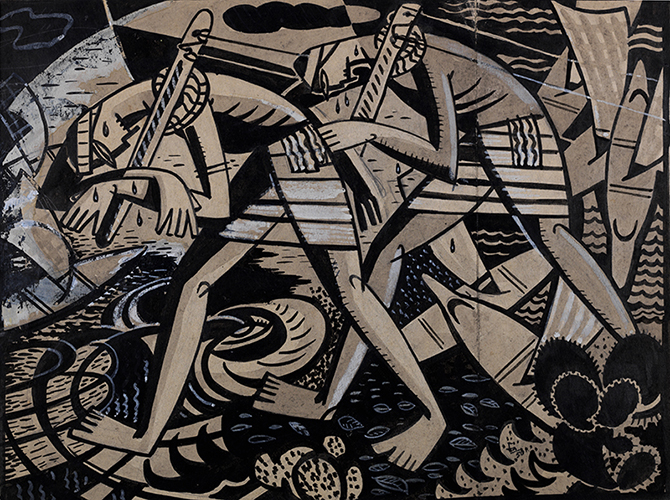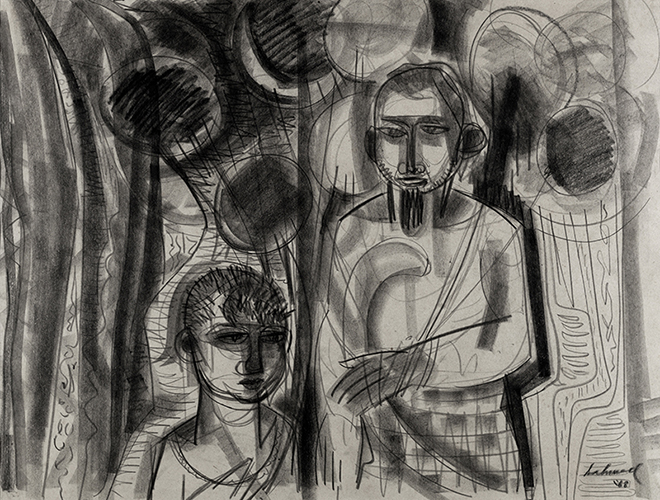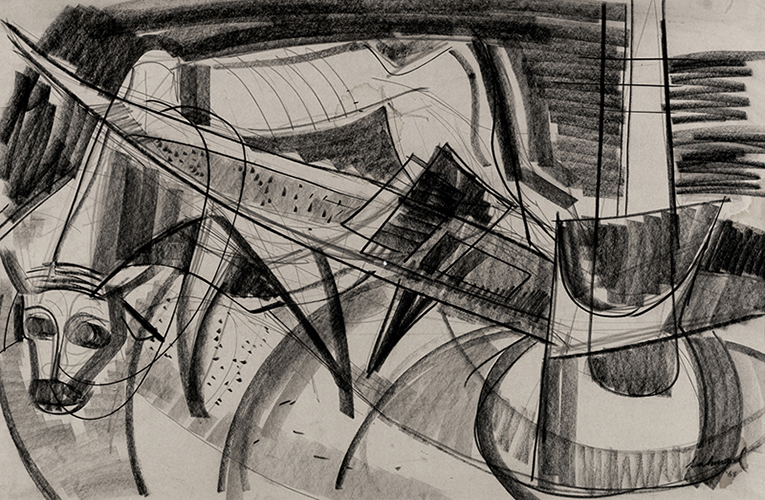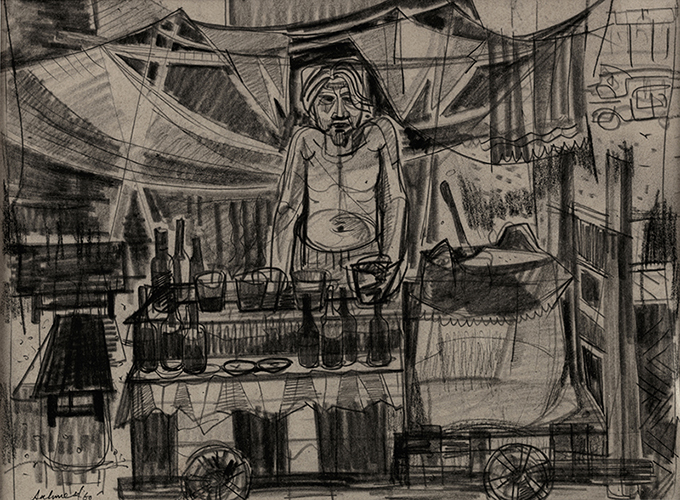Line-Drawing
The lifeblood of Safiuddin Ahmed’s artistry lies in the drawing. In the long assembly, he has transformed each of his lines into a complete picture. And it is true that the potential of an artist’s true energy and inventiveness can be realized most in his drawings. This is equally true for artist Safiuddin Ahmed.
After enrolling in the Calcutta Government Art School (1936), he mastered the art of free-hand drawing in the school blackboard in the class. He then enriched this school education only through lifelong practice. Drawing is part of his regular art practice. Even though he was bedridden due toillness, his practice did not stop completely. His last sketch was in 2008. His collection contains diagrams of the last seven decades. The first of these was created in 1945. His sketches are so varied in subjectivity and stylistic observation that the viewer has to be stunned in amusement and lost in its beauty. His lines are sometimes soft, sometimes firm, sometimes freshly sensitive, sometimes simple bent, sometimes creepy flexible, sometimes subtle and slender, sometimes thick and swollen, sometimes vibrating and moving, sometimes straight, and sometimes sharp and tranquil. These paintings by Safiuddin Ahmed are proof that the various forms and postures of the line have become indicative of various forms. His paintings are not just bound in linear, that is, they are not just prominent outline drawings. Just as modern art has elaborated on the concept of diagram, giving it the status of a full-fledged painting, so too has Safiuddin Ahmed been inspired by such an ideal. Tonal drawing, mixed-media drawing, mural drawing etc. have been added to his sketch-world with that inspiration. With the help of a charcoal crayon, he created light and dark layers of brightness in his drawings. Tonal variation creates a variety of formative variations, different shades and concepts of perspective. In mixed medium sketches, he sometimes applied watercolor, sometimes altered the shape of a print with the help of a charcoal-crayon, breaking his own imagery. From the plan of the mural-picture, he created a well-arranged diagram divided into different perspectives. In his sketches an extraordinary harmony is created between the formal space and the negative space, which is the result of the artist’s long concentration and well-planned.

The identity of real life and patriotism is clear in the subject-exploration of his diagrams. Natural calamities like floods and storms, tragic incidents like flooding of corpses in the floods, refugees coming and going in the city due to floods etc. strike the sensitive mind of the artist. Fishing ,paddy-shifting, grinding, gunny-pulling, roofing, fabric selling, sell juice, sell fruit, sell nuts, sell balloons, printing press, potter, boat-fish-net-tree-sunflower etc. many diverse subject are arranged in these diagrams. The artist perceives this diverse world of life on a daily basis and presents its essence in the framework of diagrams.
Although some of Safiuddin Ahmed’s sketches have been drawn as a pre-planned draft of one of his prints or oil paintings, most of them have been formatted as full-fledged paintings. We get a printout similar to the sketch of ‘Scene of Santiniketan’ drawn in ink in 1945 through Dry Point. The artist has realistically arranged the dynamic life of the people in the bullock carts or on foot in the long rows of palm trees of Santiniketan and the open-air sky and the rough-red soil in the background of nature. In this picture, he wants to make the mobile life close to the ground meaningful in terms of the vastness of nature. With that, the subtlety of his drawing and the skill of composition have been revealed.
The vibrancy of the new life of the artist who came to East Bengal can be felt in the paintings of roofing with ‘Guntana-1, Mach-Dhara-1, Dampotti and Behalabadok’ painted in ink-pen and brush in 1950. Combine rhetoric and decorativeness are shown in the first three paintings which drawn as a wood-carving layout. In all the three paintings except for the women’s paintings, the artist has embodied the Bankim body language of the hardworking people with amazing skill. The identity of the artist’s craft in creating the bankim line is clear in these paintings. The distinctiveness of the posture is easily visible in the paintings: Guntana-2 and Guntana-3 painted in ink-brush in 1951. In the image of ‘Guntana-3’ the concept of perspective has been made clear by enlarging the shapes and it has evoke the style of folk art has flourished in it.

He still has in his collection a few pictures of the nude poses that the artist practiced according to the school curriculum while studying in London during the 1956-59 period. These linear figures, drawn in carbon and lead pencils, illustrate the various form of the human body. Different curves of the body have been clarified. In these paintings, the artist’s awareness is noticeable in maintaining the proportional harmony of the various limbs of the body, in the proper arrangement of the shapes in the figure and in the proper development of the movement and tension of the body. The image of ‘Nagnika Anushilan-1(1956)’ has a format of straight line. This seated body has one leg matched, one leg bent. In the painting ‘Nagnika Anushilan-2’ (1958), the artist has crafted the art of transmitting the energy and motion that is transmitted across the whole body by bending the head as it bends over the thighs of the knees. Among the paintings painted in 1959, ‘Nagnika Anushilan-3’ in which Nagnika is leaning on the elbow of one hand, in ’Nagnika Anushilan-5’ she is sitting on a bed with one foot on the floor and one is in a chair, ‘Nagnika Anushilan-4’ has the strategic format of spreading on both sides; by making these order the images have achieved different dimensions in. The image ‘Anushilan-2’ has a nice proportional adjustment and the ‘Anushilan-1’ image has a sense of smooth movement throughout the image by adopting the creative qualities of the hand part.
After returning to Dhaka from London, that is, since 1960 the beginning of a new trend in the sketches drawn by the artist. Using charcoal, crayons, and carbon pencils, he created a new kind of diagram, a different connotation that he gained by using tones, not just linear ones. The action noise of hard working people as a part of daily life has been included in the subject matter of the diagrams created in the period of 1960-68. Painted on a flat surface without any perspective, these lines create a wonderful feature of light and shadow by creating different levels of brightness. As a result, this collection of paintings has become prominent in black and white. The image of the ‘printing house’ is particularly noteworthy in this context. These paintings are significant in the creation of different dimensions of tone, different forms of light to dark. Beyond the thematic splendor, stylistic skills have become the key.

This trend of drawing continued until the late seventies and eighties. Boats, sunflower vandalized forms, floods, chicken cage, etc. have been adopted as subjects in various ways. The vandalism of form is an important feature of this episode. This is especially noticeable in the two films titled ‘Suryamukhi-1’and ‘Suryamukhi-2’. The familiar form of the figure in modern painting is no longer adorable in any way. The achievement of the modern artist depends on how the familiar form can be broken by keeping the artistic unity. The signature of Safiuddin Ahmed’s craftsmanship is quite clear in these two paintings. He also painted ‘Ghani-Tana’ in the sixties. Although the same subject is used in this episode, there is a considerable difference in the face of the cow, the form of the grinder and the degree of brightness of the whole image. A more important attempt at experimentation with diagrams became noticeable among the artists at this stage. Charcoal, crayon, carbon pencil, etc. have been used to differentiate the image on the two interpretations of the print titled ‘Ekushey Smarane’ created through engraving. It can be identified as a mixed medium diagram. There are tears around the head, there are tears, there is pain, there is intense-deep-deep affection and affection for the language and the country. In the line drawn from this form of print, in ‘Ekushey Smarane-1’ the thought-anxiety -pain has been made inward and in ’Ekushey Smarane-2’ the outward meaning has been spread outside. By deleting some of the imprint in the image and creating a new image and creating a tonal application under the image, the two diagrams are publishing a completely new, unique application. In the diagrams of the nineties we find a new Safiuddin. In the sketches of the ‘Black Series’ drawn from 1992 to 1995, he is engaged in a creative experiment with black. The attraction towards black color is from his student life. It seemed to him that the artist who could use black with skilled hands dominated all the colors. As a result, he has visited Sheyalda station in Kolkata many times to practice the colors of the night. Then in London he took obtainment in teachers to learn the art of mastering black. His print spontaneously revealed that the black color could not quench the artist’s thirst for discovery. In the nineties, he was able to successfully unleash the splendor of black in ‘black-line’In contrast to black, he brings out a variety of light. Seeing that, the only thing that comes to mind is the name of a book of poetry by Buddhadev Basu: ‘That darkness is more than light’. His black paintings have shown remarkable design qualities. The surface of most of its images is bounded by a thick black border. Watercolor and Chinese ink have been used with charcoal crayons. In many of the paintings, the artist plays a kind of fun game with the form of trees and leaves. In some figures the form is completely unfamiliar, culminating in abstraction. We notice the reuse of the images that have been used in his prints since the fifties. He has also used etching-fine-thick-perpendicular lines with these images. Boat nets and fish motifs have been used in the same process. His goal was to develop the appeal of other mediums in the diagram. And his success in this work is also commendable.
Not only in the black series, but also in his other sketches from the nineties onwards, the artist has been experimenting in all aspects. In this episode, he has focused on highlighting all the features of his prints and oil paintings. He has enriched the surface of the sketch by applying watercolors directly, as well as using fine-grained lines of etching, rough-wound lines of engraving, poetic lines of dry points, fine granular properties of aquatint, smoothing of various layers of oil paint. In such modernized experiments, the diagram of these mixed media has gained a more successful form. The profound significance of this period can be revealed in a separate analysis of a few images.

In this episode, he drew an outstanding sketch,’ sukh dukkher Bangladesh’ (1994), which highlights the features of the mural. As the mural depicts an attempt to evoke a larger idea or a longer journey of a nation through a combination of various scenes, this painting also has a similar format of subject matter. Aquatint’s spongy softness feature has been brought to the line drawing of ‘Leafless Tree’ (2004), after the storm. The white horizontal part holds the whole image. It’s line has tremendous motion. Various geometric forms have been created to maintain the harmony of the composition. The same appeal of aquatint is evident in the image of ‘Jal ebong Mach’(2005). The background of the figure and the same tone of the fish-net, both separated by white only. As the fish are drawn vertically, its form has gained extraordinary speed. The idealized form of fish that has been created is very visually pleasing. The composition of the three fish has created an excellent geometric harmony. The main theme of the film titled ‘Brikkho-4’ (2006) is composition. In this image, which is placed opposite the light, the part on the right side has been blackened to balance the form of the tree. Since the base of the tree can be seen, the part has been illuminated, while the leaf part has been made dim. The balance of light and darkness has been created in the formation.
Safiuddin Ahmed is always prone to audit. The desire to transcend oneself is always strong in him. That is why he is not stuck anywhere. His sketches are marked in more detail by repeated attempts to bend and constantly experiment. As a result, his sketches have become so diverse, consonantal and artistic.
Art historian and Art critic Professor Syed Azizul Huq, Chairman, Bangla Department, University of Dhaka
Translated by: Noshin Shamma and Priyanka Chowdhury
Edited by: Priyanka Chowdhury